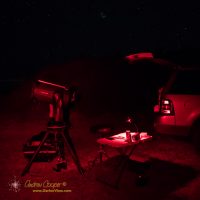It was a very nice night, clear dark skies and bright stars.
A usual the club’s dark sky star party was held this month at Kaʻohe. After two months of poor weather I was ready for a good night out with a telescope. A few others were too, and joined the club out in the dark.
Arriving at the site there was a thin cloud deck overhead. With years of experience here I looked up and told Maureen that the clouds would be gone in an hour. It did not even take that long, the clouds dissolved right after sunset, leaving a clear skies before we were finished setting up.
Since we have had some larger groups lately I have ensured a DLNR permit is in place each month. This is required if the group size gets above ten people attending.
It turned out we did not have ten… Maureen, Andrew, Cliff, Andre and Anna, in addition to myself. Five telescope to greet the dark sky, nothing big, six to eleven inches.
The darkening sky was dominated by Orion and Canis Major, the bright wither constellations directly overhead. The western sky was completely washed out by the zodiacal light, a bright cone of light coming up from the horizon.
I found myself working down low, South of Canis Major into Vela and Carina. The area is rich with open clusters and planetary nebulae. Since the constellations were culminating, this allows access to an area of the southern sky not visible from further north. From Kaʻohe the constellations are seen right over the summit of Mauna Loa.
For the evening I was using the 11″ NexStar, a telescope that has gotten a lot of use lately. I would be hunting faint, obscure objects and the GOTO would be very useful. After a day of household projects and chores it would be nice to sit at the eyepiece.
Adhara – A bright blue-white star with a faint companion 8″ to the south, the very bright (1.5mag) primary almost hides the very dim companion (7.5mag), a true binary and once the brightest star in the sky
PK239-12.1 – A very faint 15mag planetary, a very faint halo around a dim central star, 1/2′ across, round, no color noted
Wray 16-41 – A very faint smudge of light around a faint star, round, no color noted, no other structure noted
NGC2867 – Small 20″, bright, central star visible, round, no structure noted, no color noted
Most of the group left around 11pm, leaving me alone in the dark. I hung out and observed another dozen objects, filling out another page in my notebook.
NGC3132 – A beautiful planetary!! bright with a very bright central star, notable green color, an obvious annular structure
NGC2818 – A nice planetary nebula seen against an open cluster, small, round, faint, no color noted, no structure or central star, about 1′ across
TR9 – An odd clump of stars with a central bar of four brighter members, coarse, bright, fully resolved
NGC2452 – Small, round, bright, no structure or central star noted, no color, just south of cluster NGC2453
NGC2453 – An odd misty patch outlined with brighter stars, triangular, not resolved, bright
As I packed up I noted how cold it was, understanding why everyone else had left. Just how cold? Yes, the top of the telescope case was covered with ice where the dew had frozen.




Wow frozen dew in hawaii, who woulda thought. Nice report andrew.
Aloha